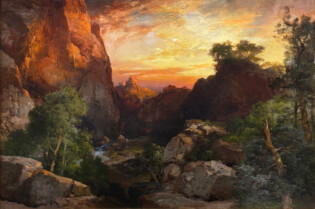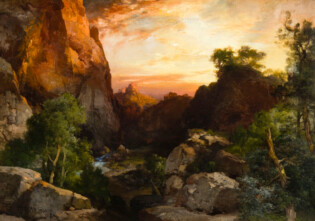Moran, Thomas
Yet this most American of artists was English–at least at first–as English as Lewis Carroll. Moran was a weaver’s son born in Bolton, England in 1837. At the age of seven, after the swift and violent collapse of the hand weaving industry in the face of industrial textile mills, Moran’s family emigrated to the United States. Moran apprenticed with an engraver, saw the works of the English artist J.M.W. Turner, and thought Turner’s light and atmosphere worth emulating here in the vastness and variety of the American landscape. Like Turner, Thomas Moran was a romantic. He loved Longfellow’s Hiawatha and Lord Byron’s poems, lost himself in their remote, craggy lands, ruins of lost civilizations, and brooding solitary wanderers.
In the fall of 1870, while working for Scribner’s Monthly, Moran was asked to work up some crude sketches from the first scientific expedition to a place called Yellowstone. Excited by descriptions of the place, Moran secured a spot with the geological survey headed to Yellowstone and led by Ferdinand V. Hayden. Hayden’s report to Congress, William Henry Jackson’s photos, and Moran’s paintings, which would also be reproduced magnificently in stone lithographs by Louis Prang, would lead to the establishment of Yellowstone as our first national park. Moran’s last stop on that train in 1870 was a boom town beside the tracks, a place called Green River, Wyoming. Moran stepped off. The fantastic forms and colors of the rocks met his eye and fired his imagination. He would return to them again and again throughout his long career.
For Thomas Moran, who would turn 70 in 1907, time was on the march. He was already the “Grand Old Man” of American art with a white beard as long as the list of accolades he’d received. His wife, two of his brothers, and his only son had recently passed away. Art was changing. Modernism and the new, urban century were rising together. Moran responded to grief and the changing world by throwing himself into his work. He traveled with his daughter and painted throughout the West, as well as returning to Great Britain, the country of his birth, to paint in the mountains of Wales. 1907 found him back in the West, plying brush and pen.


